| |
"An existential thriller – the most original and shocking French melodrama of the 50s… Henri-Georges Clouzot directed his own adaptation of Georges Arnaud's novel. His most controversial film, it is also his most powerful; the violence is not used simply for excitement – it's used as in Eisenstein's and Buñuel's films: to force a vision of human experience." |
| |
Critic Pauline Kael on The Wages of Fear* |
If you're too young or too new to the wonders of world cinema to be unaware of the defining factor of Henri-Georges Clouzot's 1953 The Wages of Fear [Le salaire de la peur] then consider this little scenario. Have you ever bought a round of drinks at a pub and struggled to carry two or three full-to-the-brim pint glasses back to your waiting friends without spilling at least a little of the contents onto your your hands? Tricky, isn't it? Now imagine trying to do that on a wildly uneven floor whilst moving slowly on a motorised skateboard. Then imagine that it's not beer in those glasses but a highly unstable liquid that will explode if a single drop hits the ground, and the blast that it triggers will be so massive that it will not only take out the pub, but the entire street in which it is located. How fearful do you think being required to do that make you? Ponder on that for a few seconds and you'll have an idea of what makes The Wages of Fear one of the most nerve-wracking thrillers in cinema history. That said, If you come to the film expecting start chewing your nails in fear from the off, the first hour is likely to have you wondering if you've put the wrong disc in the drive.
For so many films today, things like scene setting and character building are viewed as unfortunately necessary evils that ideally have to be skipped through as quickly as possible. In stark contrast, The Wages of Fear takes its sweet time on this score. Indeed, we're 37 minutes into the 131 minute runtime before we get even the smallest hint of the story and associated genre switch to come, and 20 minutes more before what begins as a drama becomes a fully-fledged thriller.

It begins symbolically in the small isolated South American town of Las Piedras, on a close-up of several cockroaches tied to each other and struggling to break free. They're being watched over curiously by a half-naked local child, and when the boy becomes briefly distracted by a passing ice cream vendor, the insects are consumed off-screen by a vulture. As has been noted by many a commentator, including several on this very disc, it's an image that was reworked to similarly metaphoric effect by Sam Peckinpah for the opening of his genre-transforming 1969 western, The Wild Bunch. We then get to meet some of the people whose options are as constrained as those of their now departed insect cousins. A multi-national collection of white male outsiders (five different languages are spoken in the space of a just couple of minutes here) are lounging in the daytime heat on the porch of a bar run by an irritable Latino named Pepito Hernandez (Darío Moreno). Each man has landed in Las Piedras as a last resort and now none now have the means or the funds necessary to be able to leave. The only roads lead to the headquarters and various wells belonging to the American owned and operated Southern Oil Company, and the only way in or out of the district is by airplane from the local airstrip, and none of the men has the money for even the cheapest ticket. They're disliked by Pepito, who regards them as layabouts but intermittently tolerates their presence, despite the fact that they only ever stretch to a single lemonade between them.
When the ice cream vendor stops at the bar, one of the men, a middle-aged German named Hans Smerloff (Jo Dest), grumpily starts throwing stones at the vendor's dog. "I hate mutts!" he complains to good-looking Corsican Mario (Yves Montand). Inside the bar, pretty young Linda (played by the director's wife, Véra Clouzot), whom the exploitative Pepito appears to have firmly under his thumb, is unhappily scrubbing the floor. Her face brightens considerably when she catches Mario's cheerful glance, and in a somewhat more blatant and discomforting slice of character symbolism, she scurries over to Mario and rubs her head appreciatively against his hand like a devoted pet dog, which earns her an affectionate pat on the head. Following on so rapidly from Hans' mistreatment of the ice cream vendor's canine as does, I have no doubt that this reading was always intended. It proves particularly pertinent to the unfortunate Linda, who is treated like a slave by Pepito, and used by both him and Mario as a sexual plaything but is otherwise treated shabbily by both, despite being head-over-heels in love with the latter. Also stranded in the town and even more desperate to leave is young Italian Bernardo (Luis De Lima), who is convinced that he can persuade a sympathetic pilot to let him ride for free with the baggage in one of the planes used to transport mail and passengers in and out of the region. Employed to do odd jobs by Pepito, meanwhile, is blond-haired Bimba (Peter van Eyck), but as he's still owed several weeks of back wages, he's financially no better off than the others. The only one with a regular income is Luigi (Folco Lulli), a jovial Italian with whom Mario lodges and who is employed as a construction worker at the Southern Oil Company headquarters.
The dynamic of the town, or at least how it affects this group, is disrupted by the arrival of Jo (Charles Vanel), a well-dressed, middle-aged Frenchman who uses the last of his money to bribe the airport's lazy customs officer to ignore the list of known criminals on the desk in front of him. He takes a taxi into town and asks the car to wait while he takes a look around, and is on the verge of departing when he susses that he and Mario are compatriots and hooks up with him, conning the taxi fare and seemingly endless drinks from Pepito on the basis of the man he appears to be. He and Mario quickly become the best of buddies, which leads to them both being effectively ostracised by the rest of the group and pits Mario and Luigi (Nintendo fans must be hugging themselves with glee about this pairing) against each other. It even drives a wedge between Mario and Linda, with Mario favouring Jo over her at every turn and seemingly treating her even worse than before just to show what a tough guy he is to a man into whose thrall he has quickly fallen. If you've been searching for a prime example of a screen bromance, you need look no further.

Before I go on, I have to pause for a minute and address the small issue of Bimba's nationality, on which there seems to be some disagreement. Most reviews, and indeed the film's Wikipedia page, claim that he is German, whereas a select few, including the detailed synopsis on the film's IMDb page, have him as Dutch. I tend to side with the latter, for a couple of reasons. The first is really simple. Only at one point in the film does any character mention Bimba's nationality, and that's when Jo refers to him as "the Dutchman," and yes, I did check that the English subtitles are an accurate translation of the spoken French. The second reason is that, while we're clued in at an early stage to nationalities of key characters by the language they speak – Pepito and Linda speak Spanish, Luigi and Mario first greet each other in Italian, and Hans delivers his second line of dialogue in German – no such identifier is used for Bimba, who speaks French and English with the accent of someone who hails from neither nation. And then there's the story that Bimba tells Luigi of being forced to work for four years in the salt mines by the Nazis after they executed his father. If he was German, this would mean his father was likely either a communist or a Jew, but if Bimba was Dutch, then he could have been one of the thousands of men in Nazi occupied Netherlands who were shipped to Germany to fill a range of often dangerous manual work vacancies, a forced labour process known as Arbeitseinsatz. I have a sneaking suspicion that Bimba is assumed by so many to be German because he's played by a German actor and has blonde hair. Anyway, back to the story.
Put aside the knowledge that an unstable truckload of tension is on the way, and this first hour still makes for compelling drama. Characters are key here, each of whom are impeccably cast and economically sketched, while the drama that unfolds pits former friends against each other in conflicts that build to sometimes perilously dangerous confrontation. Individual scenes are impeccably handled. The briskly paced, whistle-stop expositional montage in which Mario outlines to Jo just why there is no easy escape from Las Piedras for men such as them is later underscored by a tragedy, one that is revealed to the audience in a perfectly timed pan before being noticed by the person the camera movement was following. There are faint echoes of Casablanca, meanwhile, in an electrifying barroom scene that pits Jo and Mario against Luigi in a battle that is instigated by music but quickly escalates to the threat of lethal violence.
Theoretically working against the drama, but actually spicing it up a little, is the fact that some of the very people we are expected to root for behave reprehensively and are driven almost solely by self-interest, something especially true of Mario and Jo. Indeed, you could argue that Linda's primary function in the story is to show what self-centred shit our Mario can be, as if that wasn't already clear from the casual racism that he throws around to impress the equally racist Jo. Mind you, he later looks like an amateur when compared to Bill O'Brien (William Tubbs), the American running the Las Piedras branch of the SOC. When he first hears his name, Jo's eyes light up, as the two were in cahoots in some unspecified shady dealings back in 1932. Unfortunately for him, his hopes of leaning on his old friend for paid work are quickly quashed by O'Brien's assurance that if the company got wind that he'd hired a man with Jo's record, both of them would quickly find themselves unemployed.
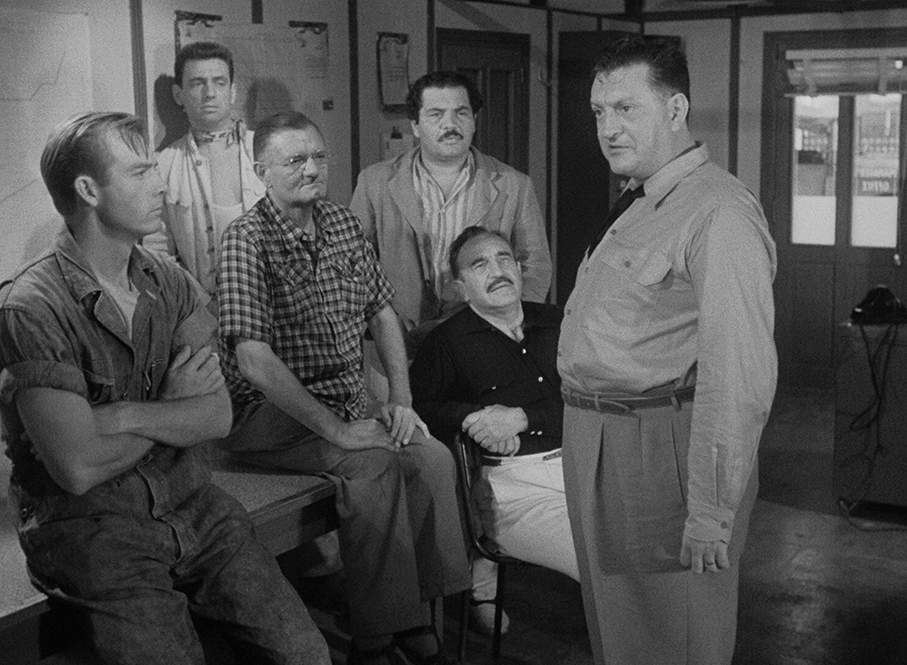
The first indication of the direction that the story will soon takes comes when several local people are injured and killed by a gas pocket explosion at one of the SOC wells. Revolution is in the air, and the pressure is on O'Brien to find a way to extinguish the massive fire that the incident has triggered, one that will continue to rage until the oil runs dry. His plan is to blow the fire out with second explosion using nitro-glycerine, which will need to be transported from the main facility to the affected well along many miles of rocky and treacherous mountain roads. Given that a single sharp bump could cause the notoriously unstable nitro-glycerine to violently explode, the mission is a potentially suicidal one. This doesn't exactly trouble O'Brien, who displays a complete lack of compassion when he tells the foreman at the affected well to make sure to ply the visiting Safety Commission representatives with booze and to put the blame for the accident on the victims. Knowing his plan to transport the nitro-glycerine will be resisted by the union, he suggests that they put out a call instead for drivers from the local populace and offer them $2,000 apiece if they complete the run and select the four best drivers from those who apply. They'll be carrying so much nitro each that theoretically only one of the trucks needs to get through, and by separating their departures by half an hour, if one should ignite, the other should be safely distanced from the resulting explosion. If all four were somehow to be killed and the lorries destroyed, well O'Brien will just recruit another four drivers and start the whole process again.
Unsurprisingly, almost every male in the town not already gainfully employed shows up and claims to be a truck driver by trade. Those who make it through the initial recruitment process are shown just how volatile nitro-glycerine is and then tested by O'Brien on their driving skills, and if you've not seen the film or the stills commonly used to promote it and don't want to know who is selected to drive the trucks, then hop to the final paragraph of this review or click here to do so automatically.
Even before the driving tests are complete, most should be able to predict which four men will be chosen by O'Brien, or at least who will end up driving the two trucks. Having previously mocked the risk that Mario is willing to take to take in favour of the relative safety of his construction job, the news Luigi receives from the camp doctor that concrete is destroying his lungs has prompted him to also throw his hat into the ring, and it's thus no surprise when he is selected. After sternly warning the applicants not to mess with his test as they did with Bernardo's, it seems likely that Bimba will also be picked, and as Yves Montand is the headline star and his face dominates the poster for the film, it's clear that Mario will be too. The one surprise is that Jo, despite his former friendship with O'Brien, is passed over in favour of Hans. "You're too old, Jo," O'Brien tells him in confidence afterwards, "and so am I," seemingly ignoring the fact that Hans looks to be about the same age. The argument that follows concludes with O'Brien promising that if any of the others drop out, then Jo will be first in line to take their place. This proves fateful for Hans, as when the other three meet with O'Brien in his office that night and suit up for the job, there's no sign of Hans. Tellingly, he was last seen earlier that evening walking off with Jo, who then pops cheerily through the door to wish his pals a safe journey. What's that? Hans hasn't shown up? What could possibly have happened? It's lucky I dropped by so unexpectedly, then. Faced with no other option, O'Brien tells Jo to suit up, and the four drivers head apprehensively outside to their vehicles.
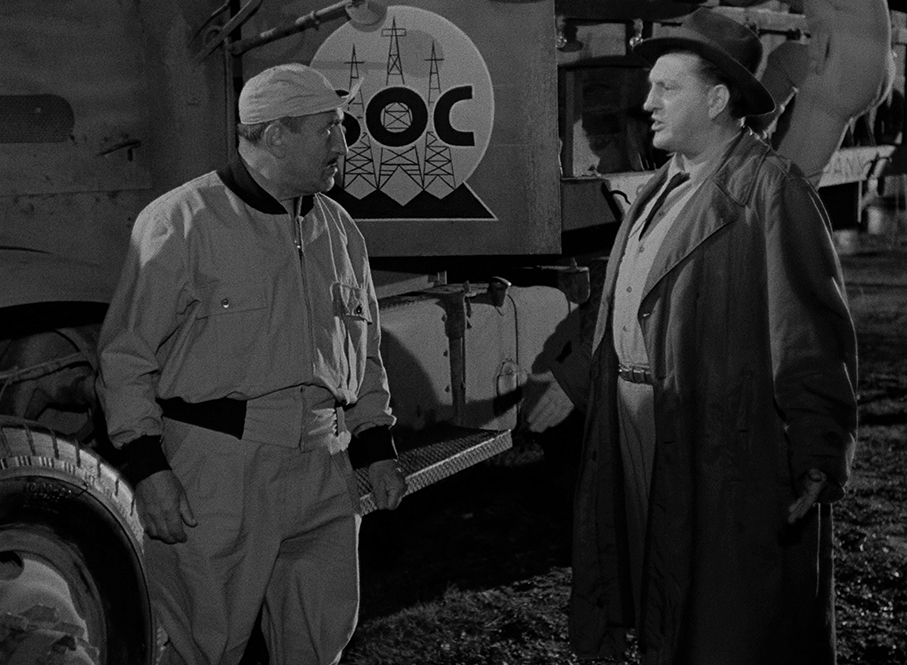
Two trucks of differing weight capacities are loaded, the heavier of which will be the first to depart and is assigned to Mario and Jo on the toss of a coin. Before they get going, Jo insists on thoroughly inspecting their vehicle, a theoretically sensible move that comes across more as a delaying tactic by someone who is suddenly having second thoughts about the whole thing. It's also here that we get our first small taste of the tension to come, when one of the workers gingerly loading the jerrycans of nitro-glycerine onto the tucks slips and nearly stumbles, prompting the stiffly watching Bimba to drop the glass that he was holding.
Oh yeah, and while we're on that… I know times have changed when it comes to on-screen representations of what were once regarded as harmless vices (how often do you see people smoking in a social setting in movies these days?) but considering that these men are being tasked with transporting a dangerously unstable liquid over miles of rough and treacherous roads, you'd think the steadiest of hands and clearest minds would be essential. Yet the drivers spend the evening leading up to the departure time in Pepito's bar throwing booze down their throats, and just before they leave O'Brien pours them all a sizeable whisky to see them on their way. If I was one of the drivers and drank like that so close to leaving, fairly certain that my truck would collide with something and explode before I even got out of the compound.
What follows is 80 straight minutes of fingernail-gnawingly tense scenes punctuated by short sequences of respite in which the characters revealingly converse with each other, and in one case gradually reveal their true colours. The individual in question is the previously cocksure Jo, whose earlier hard man gangster persona starts to crumble from the moment the operation gets under way. Indeed, he and Mario have not got far before he insists on taking a break, making any excuse he can to avoid getting back into the cab and continuing the journey. So long does he dither that the truck driven by Luigi and Bimba catches up and ends up taking pole position, and as night moves into the searing heat of day, Jo's earlier bravura dissolves into almost childlike terror, which sees the previously deferential Mario take charge and treat his companion with sometimes hostile contempt. While it may now be a familiar trope to have a carefully planned job – often a heist – ultimately scuppered by a single fearful or duplicitous member of the team, here Jo's cowardice ultimately renders him less a danger to the others than a useless cog in a machine that really needs all of its parts in perfect working order.

The screenplay, by Clouzot and his brother Jean (under the alias Jérôme Géronimi) from the novel by Georges Arnaud, is beautifully structured, and really comes into its own once the trucks are on the move, throwing an inventive but always plausible string of potentially disastrous obstacles at this fragile two-vehicle convoy, each one of which is an mini-masterpiece of set-piece tension-building. Camera placement and editing are absolutely key here, with Clouzot, cinematographer Armand Thirard, and editors Madeleine Gug and Henri Rust delivering an object lesson in how to wring every gram of suspense from each situational difficulty that the drivers encounter. When there's a risk that a truck might topple off of an overhanging wooden platform and down a steep cliff, the camera is looking up from below to emphasise its height and the lethal distance the vehicle might fall. When the road is blocked by a boulder and the resourceful Bimba syphons off some of the nitro-glycerine to improvise an explosive solution, the camera closes in on his hands and his face as we anxiously wait for the slip that we're convinced will blow him sky high. When one individual becomes trapped and is in danger of being crushed by a slowly advancing truck, the vehicle advances towards the camera in close-up until the front bumper suffocatingly fills the screen. Repeatedly, the camera returns to what could almost be the film's signature shot, a side-on close-up of the front or rear wheel of one of the trucks as it slowly advances, hits a snag, or slips dangerously back. Never in cinema has the image of a vehicle wheel been so repeatedly nerve-wracking. That these scenes play out without musical accompaniment only adds to the tension, with the roar of the engines or the silence of concentration providing all the score that we need. If this wasn't enough, Clouzot repeatedly ups the ante by adding unexpected complications to already perilous moments, whether it be a hook on the side of a lorry that snags the support wire of an already fragile-looking platform overhang, or a small stone sent skyward by the road-clearing explosion that tumbles down the hillside towards a vulnerable can of nitro-glycerine. Clouzot also plays tricks on us with fake-out deaths that do not actually occur, and when one finally, inevitably does it comes out of nowhere, and is presented in a manner so unexpected and so cinematically creative that it delivers the most violent of jolts, despite the remarkable restraint with which it is filmed.
The cast is absolutely spot-on across the board. I learned from the special features that Yves Montand initially turned down the role of Mario until persuaded to take it by his then-wife, actress Simone Signoret. And what a break for him that she did, as the film was a huge international success and effectively launched the film career of this already successful singer. He really is good here, from his early cockiness to his later impatience and anger, as well as a late film emotional exchange that feel so genuine that it brings a lump to my throat on every viewing. The film was also an important one for Charles Varnel, a veteran actor whose career was in a bit of a slump until selected by Clouzot to play Jo, a hard man whose bravado falls apart over the course of this most dangerous of journeys. This transformation is expertly portrayed by Vanel in a performance that landed him the Best Actor gong at Cannes, where the film was also awarded the Grand Prize of the Festival. Far less emotional but just as charismatic is Peter van Eyke as the smoothly laid-back Bimba, whose surface cool only really fails him when he drops his drinking glass after the worker stumbles whilst loading the nitro-glycerine. In a moment that has doubtless contributed to the conviction that Nimba is German, he then snaps to attention and apologises to O'Brien for his clumsiness. And then there's Folco Lulli, who creates in Luigi a character with some archetypical Italian character traits that are never played in a stereotypical manner. Of the four male leads, it's ultimately him that I felt the most for, effectively dumped by his roommate for shifty newcomer Jo and forced to take a job that might kill him after discovering that the one that he was previously doing was set to do so anyway. The most thankless role falls to Véra Clouzot as Linda, a woman whose backstory we can only guess at and who is used and abused both by a man she adores and one she clearly dislikes but somehow feels pressured to obey. It's to Clouzot's credit that she brings so much life to the character beyond the exotic eye candy she is effectively cast as, enough to make me wish she'd forget about Mario, break a chair over Pepito's head, and find a way out of this dead-end town and start a new and more fulfilling life elsewhere.
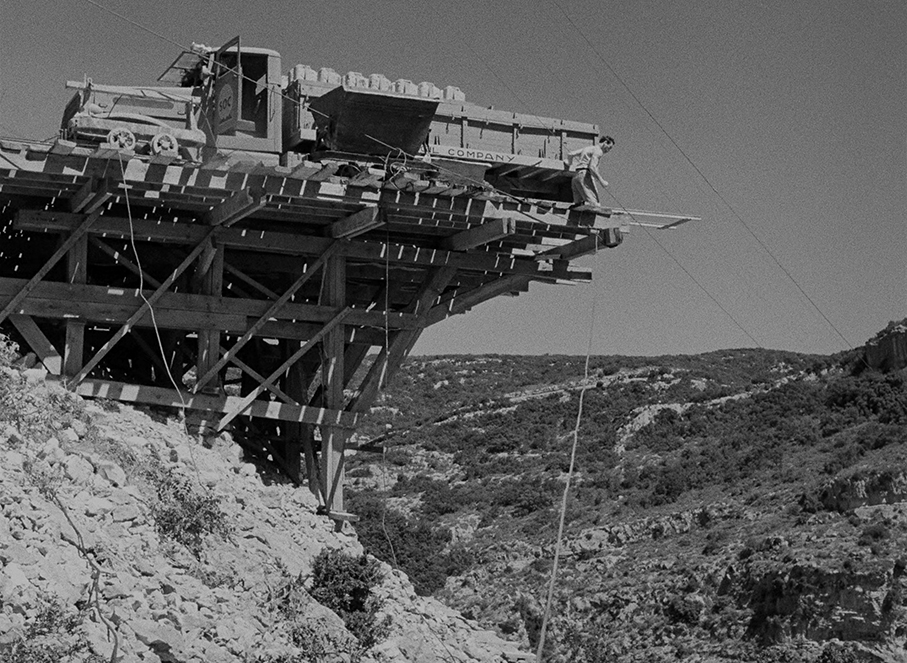
As you've probably gathered by this point, The Wages of Fear is a personal favourite about which I could write reams more and still be frustrated that I've somehow sold the film short. And while its effectiveness as an almost nihilistic existential drama has already been explored in considerable detail by writers more informed and talented than me, I feel sure that I could still write several detailed paragraphs on just about every immaculately handled scene in this superb film. It's a small miracle of construction, impeccably translated to the screen, and one of the most unremittingly tense and refreshingly unpredictable thrillers in cinema history. It's a film I first saw in a version severely cut down by its American distributor, which censored the nudity and sequences that portrayed American corporate capitalism in a cruel and uncaring light, elements that were subsequently restored and now feel even more relevant than ever. Many years ago I helped arrange a screening of a 35mm print of the film for a cinema audience, and I still remember collective gasp and physical reaction (people were almost backing out their seats) at the climactic moment of the first set-piece scene, one involving corrugated road and trucks that dare not slow down on – anyone who has seen the film will know the moment I mean. But perhaps my favourite reaction came a few days ago when I ran this new UHD for my partner as an after-dinner movie treat. Despite having seen the film several years ago, she became so wrapped up in the perilous plight of the four drivers that she was shouting anxiety-laden warnings at the screen, a process that continued right up to the still-debated final scene. Not bad, I'd say, for a film that is only a couple of months away from its 71st birthday.
The opening title card on this new UHD seems to confirm that the 4k 2160p transfer on this disc was sourced from the same restoration as the one on Dual Format edition released by the BFI in 2017. The 1.37:1 2160p transfer on the UHD is certainly impressive, in no small part due to the quality of the original restoration, but how does it compare with the 1080p transfer on the Blu-ray from that Dual Format release? As I did recently with Eureka's new UHD of Paths of Glory, I was able to compare the two discs side-by-side, and the result was not as clear cut as I was expecting.
The most significant and immediately visible difference is that the image on the UHD has been graded to be darker than transfer on the Blu-ray. When it comes to the question of which of the grades is correct, I'm not sure I have a definitive answer. When watching the UHD, first alone and then again a week later with my partner, it never struck me that I was watching an overly dark transfer – this only really struck me when I compared it directedly to the Blu-ray, the image on which now looks a little too bright by comparison. That said, there are shots and sequences – the one of Linda looking over the balcony at night as the truck in which Mario and Jo are travelling approaches is a good example – when detail in the street below that is clearly visible on the Blu-ray is almost swallowed by the darker image on the UHD. This proves to be less of an issue if watching the film in a lamplit room (my personal preference), as the Dolby Vision HDR restores a much of the detail that initially seemed lost, but still renders it noticeably darker than it appears on the Blu-ray. The daytime highlights, however, are more subtly handled by the UHD, even if the image here never feels really bright, even when the characters are bathed in sunlight. If I had to choose, my ideal grading would probably sit somewhere between the two, though I could probably achieve this by brightening the UHD a tad by tweaking the picture settings on my TV. This is not acurately represented by the screen grabs here due to the quirks of the software I use to obtain them. 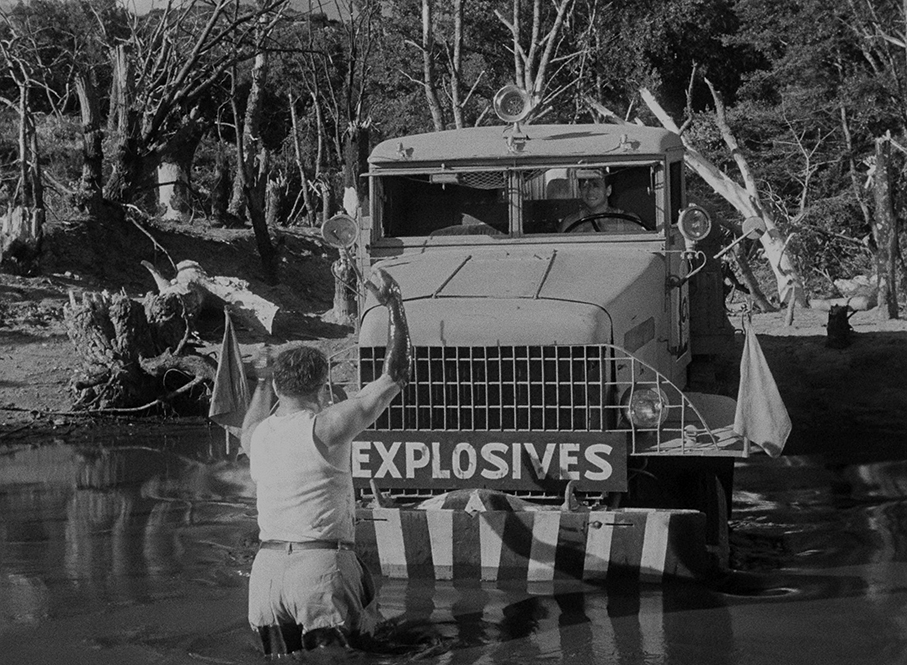
When it comes to sharpness and the clarity of detail, the difference between the two discs is not so obvious, which is less a criticism of the UHD than a testament to the quality of the transfer on the earlier Blu-ray. Look closely, however, and the improvements are there, visible in sometimes unexpected places, such as small pieces of gravel on the roadside, the texture on rocks, and particularly the small spots on the backgrounds behind the main titles, which in pre-computer days were physical objects that could pick up specs of dust no matter how carefully you cleaned them. In common with many 4K transfers, the film grain is clearly visible, but is never distracting and very much part of the organically filmic feel of the image. As so often with high definition transfers of monochrome films – and I'm still uncertain why this is – vehicle bodywork always has a pristine feel.
It is worth noting that a small handful of shots do not quite match the quality of the rest of the film, having a more aggressive contrast range and slightly less crisp detail definition – these are identified in the commentary as shots that were cut from previous releases and only reinserted for the 2017 restoration, and were thus probably sourced from a technically inferior material. It's a brief and frankly minor quality drop that most will not notice and is absolutely worth living with to see this crucial material reinstated.
The Linear PCM 1.0 mono track of the Blu-ray release has been expanded out here as Linear PCM dual mono 2.0, and while subject to the same minor restrictions in tonal range, it does feel a whisper more robust here, perhaps because it is being sent to the two largest speakers in my home cinema system. Once again, the dialogue and effects are clearly rendered, and there is no distracting background hiss or fluff during the tensely silent sequences.
Optional English subtitles for the non-English dialogue and are activated by default.
Audio Commentary by Adrian Martin
One of several special features ported over from the BFI's 2017 Dual Format release, this commentary by Australian writer and film critic Adrian Martin is jam-packed with information on the film and analysis of it, with a strong emphasis on the latter, which is divided between Martin's own readings and quotes from contemporary and retrospective writings. With two-and-a-half hours at his disposal, a lot of ground is covered, some scene specific, but just as much about the film and its director as a whole. He makes the case early on for seeing The Wages of Fear as an anti-Casablanca film, explores Pauline Kael's description of it as an existential thriller (see quote at the top), discusses its duality of identity both in the switch from realist drama to thriller and the wedding of arthouse and genre movie, and draws some direct comparisons between it and William Friedkin's 1977 take on the same source novel, Sorcerer. He examines director Clouzot's technique, praises individual scenes and shots, identifies and elaborates on the film's underlying themes, and usefully identifies material that was cut for the initial American release, as well as shots that were re-inserted for the 2017 restoration. Only once did I execute a small eyebrow raise, at the claim that the score is used to enhance tension in a second half that is devoid of non-diegetic music. Otherwise, this is a compelling and rewarding track that makes for an excellent companion to the film.
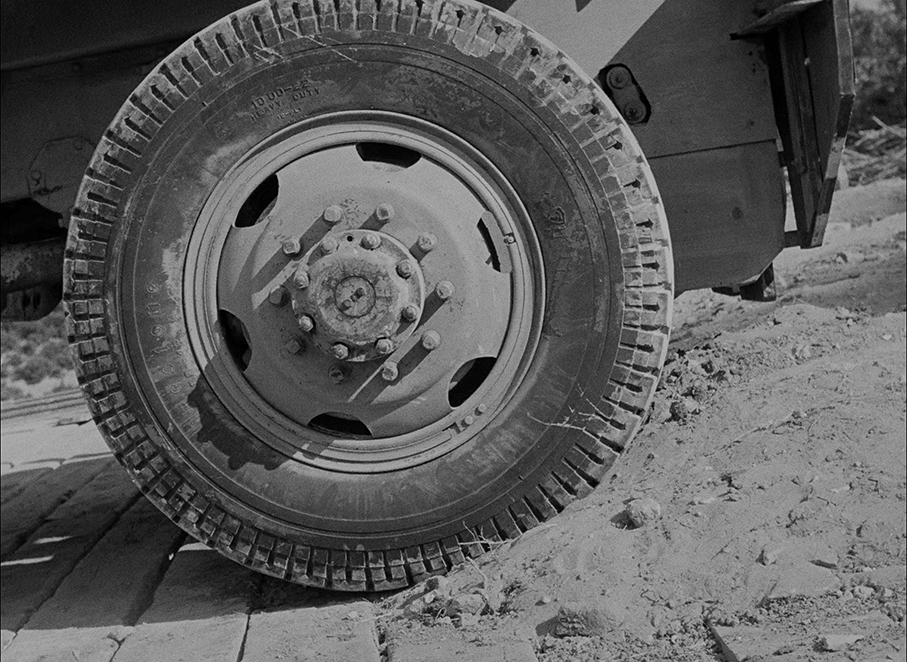
Road Trip Out of Hell? Or Into It? – Purgatory and 'The Wages of Fear' (14:31)
If you'd told me in advance that this video essay by filmmaker and photographer Nic Wassell was going to make a case for The Wages of Fears as a religious parable taking place in purgatory, I'd probably have beamed my most cynical smile, but so thoroughly and persuasively does Wassell make his case here that I now find it hard to see it any other way. A fascinating piece, not least for Wassell's observation that the logo of the Southern Oil Company resembles the most popular image of the crucifixion. As with all of the video special features here, this is presented in 1080p HD.
Interview with Professor Lucy Mazdon (34:59)
Professor Lucy Mazdon kicks off with a quick trip through director Clouzot's early film career, pausing to discuss the controversy that surrounded the release of his 1943 Le corbeau, before moving on to the production and successful release of Wages of Fear. She discusses the film's multiple themes, the almost romantic relationship between the characters of Mario and Jo, a possible reason for its popularity in the UK, and the structure and tone of the final scene.
Interview with assistant director Michael Romanoff (22:26)
The film's assistant director, Michael Romanoff, recalls being recruited by Clouzot to work on a film that he was assured would be tough work from the off, and ended up lasting almost two years due to the flooding of the purpose-built town set in Camargue. He talks about the casting of the four main leads, with particular focus of Yves Montand and Charles Vanel, and tells of the quiet word he had to have with Clouzot about the disproportionate amount of time he was devoting to filming his wife Véra due to the struggle she had remembering her lines. It's here that I finally learned what the crude oil that Montand and Vanel become immersed in was made of (I've seen erroneous claims elsewhere that it was the real thing), and there are some interesting stories about the filming of key scenes, including the ending. Romanoff describes the first year of filming as "extraordinary," and claims that despite knowing little about the requirements of the job when he started, "when you get picked up by a director of great talent, something changes in you, because somewhere there's pride to have been chosen." The interview is in English, with optional English subtitles for the film clips.
Interview with Clouzot Biographer Marc Godin (10:10)
Marc Godin, who co-authored the Clouzot biography Clouzot Cineaste, takes a brief trip through the director's early work before focussing on The Wages of Fear and some of the themes that run throughout Clouzot's oeuvre. He reveals that Clouzot was known for being irascible on set and that his own brother described him as being incapable of understanding humour. I also learned here that he had an obsession with sex that nearly led to him making a pornographic film in 1974. Given the quality of Clouzot's work in general, I'll bet that would have been something to see. Rather wonderfully, Godin describes his films as the work of someone "attempting an x-ray of the human soul." The interview is conducted in French with optional English subtitles that kick on by default.
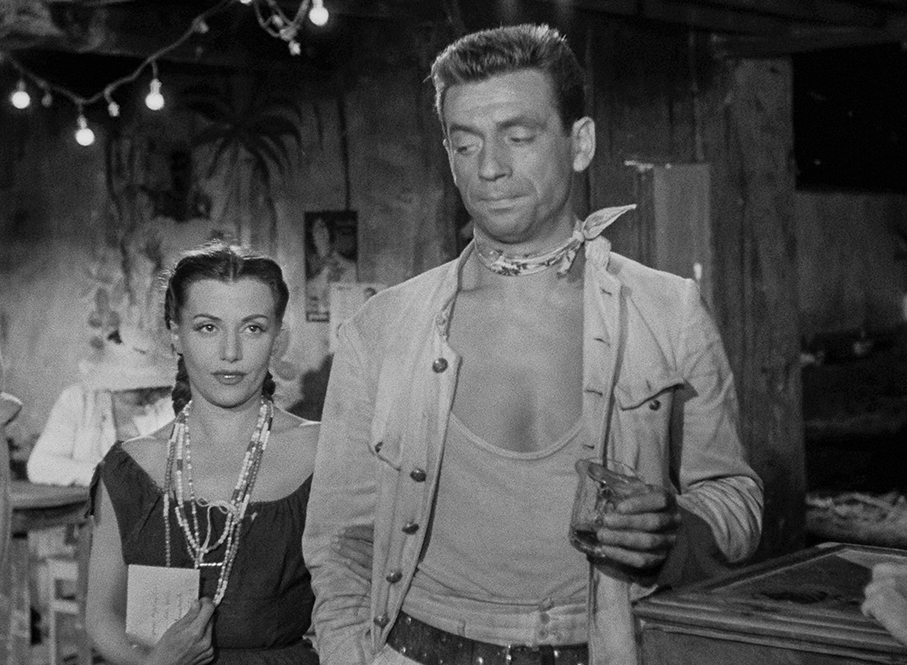
The Guardian Lecture: Yves Montand in conversation with Don Allen (108:49)
An audio-only recording from July 1989 in which Yves Montand is interviewed on stage at the National Film Theatre in London as part of a season of his films, and runs under the movie itself in the manner of a second commentary. Responding to well-chosen questions by host Dan Allen, Montand recalls his early years as the child of a family that had fled to France from fascist Italy, having to work in tough jobs from the age of 11 to get money for cigarettes and movies, and the nightclub singing that marked the birth of his lifelong musical career. He talks about first meeting and working with Edith Piaf, with whom he subsequently had an affair, and confirms that it was Simone Signoret who persuaded him to take the lead role in Wages of Fear after he initially declined due to a previously unhappy experience with filmmaking. Other subjects covered include his multi-film collaborations with Greek director Costa-Gavras, his shift from communistic beliefs to middle-ground conservativism, why he regards Jean-Luc Godard as one of the great French directors despite the tough time he had on the 1972 Tout va bien (which Godard co-directed with Jean-Pierre Gorin), and how his initial disinterest in playing the lead role in Claude Berri's much-loved Jean de Florette and Manon des sources (both 1986) dissolved when he saw himself in makeup and costume as part of a screen test. He is emphatic that the success or failure of a film – including whether the performances are up to scratch – rests entirely on the shoulders of the director, and even treats the audience to a song, a rather lovely demonstration of his still melodic vocal chords that goes down a storm.
Original theatrical trailer (3:20)
A functional trailer that kicks against expectations by equally balancing footage of the tense later scenes with material from the first hour, and despite an opening caption that proclaims grandly the film is "Unprecedented in the history of cinema," it closes with the more sobering, "A modern tragedy."
Treasures from the BFI National Archive
Three short documentary films from the BFI National Archive, two of which are silent works that have been subsequently scored, while one is so brief it counts more as a snippet than a short film per se.
They Take the High Road (24:25)
A 1960 production from British Transport Films that the story of four British Road Services drivers and the weighty goods that they haul along Scottish Highland roads, notably the seven-and-a-half ton cargos of cement they regularly transport to the construction site of the new Giorra Dam. The film sticks to the BTF formula in the staged friendly exchanges between the drivers and locals, the carefully composed and tripod mounted cinematography, and the friendly voice of a narrator who halfway through introduces himself as the drivers' boss and becomes a character in the story from then on. It's well constructed and rather enjoyable, and the links to the main feature extend to close-ups of the wheels as the lorries make way slowly up a steep hillside road. As with many of the films in the BFI's British Transport Collection sets, this has clearly undergone a restoration and it looks terrific.
Fire Checked by Explosives! (0:32)
A blazing oil well is brought under control using nitro-glycerine explosions in a brief and scratchy but still valuable grab from a 1928 newsreel from Topical Budget.
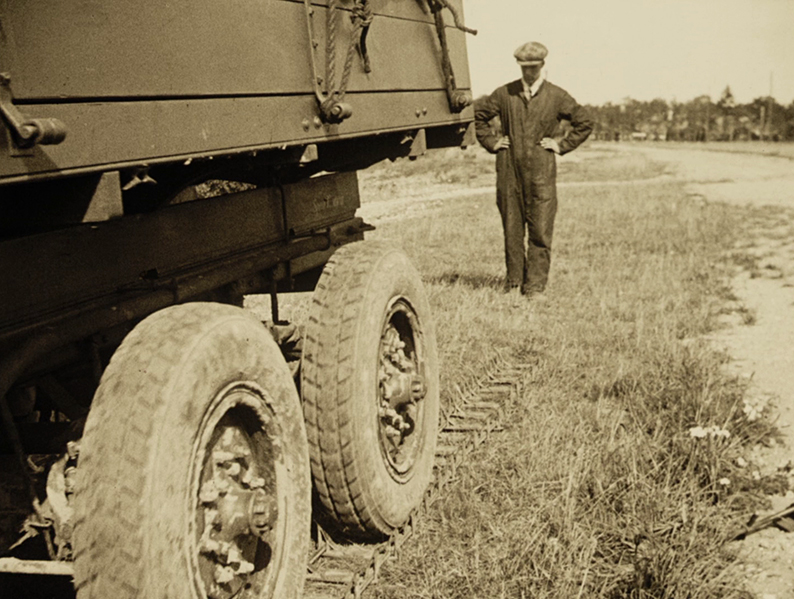
Transporting Loads – With or Without Roads (5:02)
A 1920 advertisement that sees the Thornycroft six-wheeled truck put to a string of off-road tests, all of which it passes with flying colours, of course. I was intrigued to see that you could attach the sort of tracks you find on armoured vehicles to the rear four wheels to aid grip when covering more difficult terrain. Not sure about that oddly mismatched and very modern synth score, though, and while I have no way of confirming this, it did feel a little like the end is missing – following a test that sees the vehicle barrel through a stream, a caption appears bearing the words 'Surmounting a pile of timber," which had me all excited for what this vehicle would do next, only to have the film cut off right there. I want to see it climb timber!
Booklet
The lead essay here is by author and critic Andy Miller, and it begins with a discussion about the ending of the film, so take good note of the spoiler warning placed directly above the title. Following a brief look at Henri-Georges Clouzot's early career, Miller offers a compelling examination of the film, its style, and some of its themes. Next up is areview from the April-June edition of Sight & Sound by Free Cinema pioneer Karel Reisz, who intriguingly describes the film as "a scorcher with pretentions" and makes the case for what he sees and its achievements and its failings, about which he is merciless. The review also includes a concise summary of the entire plot, including the ending, so once again this should be saved for later if you're new to the film. Similarly, a review from the April 1954 edition of Monthly Film Bulletin – which also summarises the entire plot – heaps praise on Clouzot's handling of the suspense, but criticises the film's pessimism and what the reviewer sees as the cold and unsympathetic handling of the human relationships. Full credits for the film are followed by a piece on the film career of Henri-Georges Clouzot from the September 2003 edition of Sight & Sound by Paul Ryan. Credits for all of the special features are provided, with the three BFI archive shorts each accompanied by a brief essay, including a jokey one for the 30-second Fire Checked by Explosives!.
If you've never seen Wages of Fear or have seen it and never got around to buying the BFI dual format edition, this UHD should fit the bill nicely, assuming you have the equipment to play and view the format, of course. If you have that earlier release then it's a slightly tougher call, although the bigger your viewing screen, the more you're likely to get from the resolution upgrade. Many of the special features here have been ported over from the earlier Dual Format edition, but new to this release are the three short films from the BFI National Archive and a fascinating new video essay by Nic Wassell. Whether it's worth the upgrade will be down to the individual, but on its own merits – for the film, the restoration and the special features – this still comes enthusiastically recommended.
|